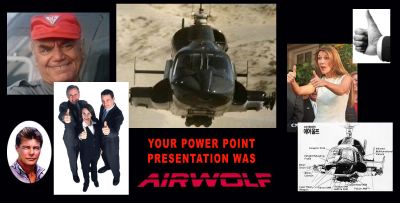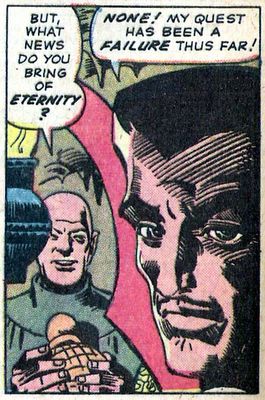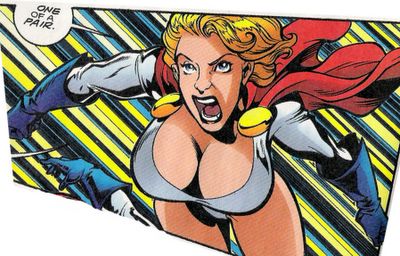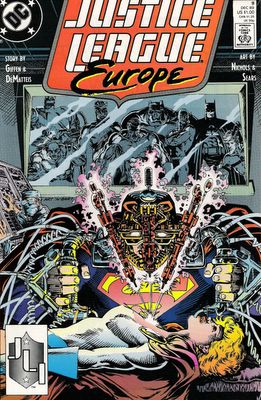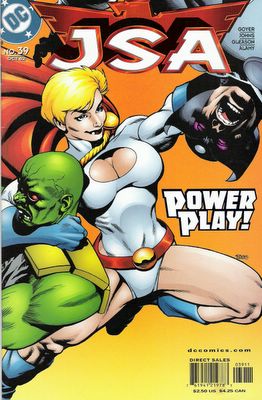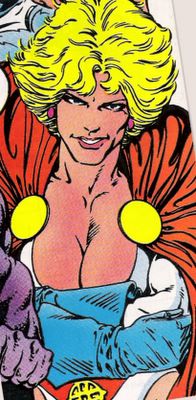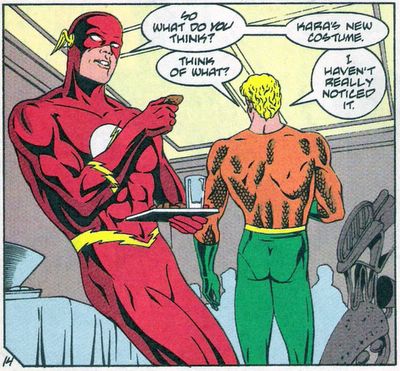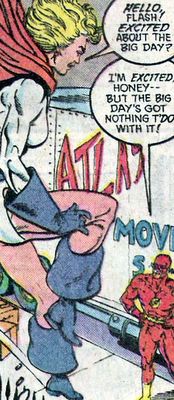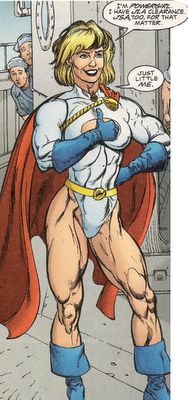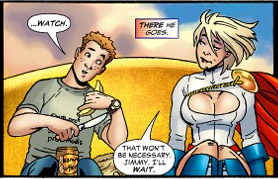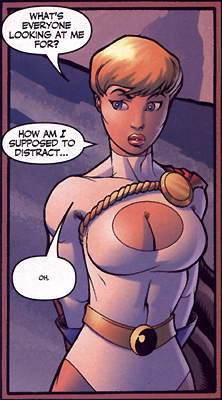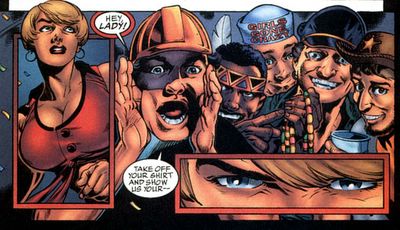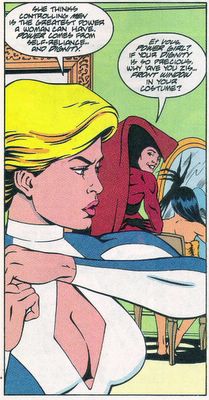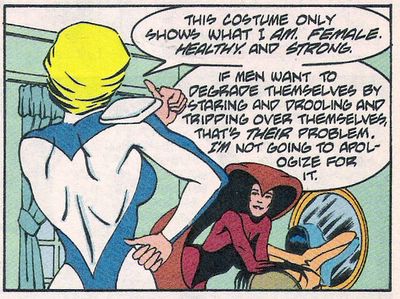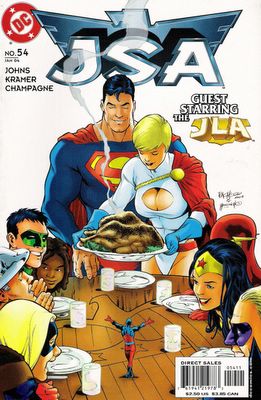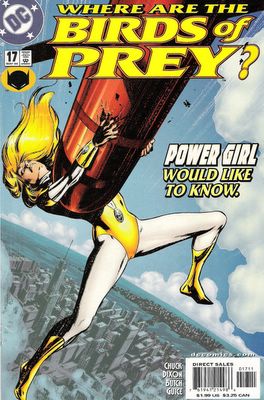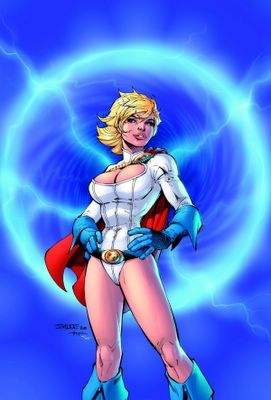Friday, September 23, 2005
Airwolf: The Adjective
Anyway, before I go, a parting gift. In the comments section Dave's Long Box readers have been discussing using the word "Airwolf" as a universally positive adjective. Rumor has it that back in the day, the producers of the hit TV show Airwolf were smoking crack and they thought, "Wouldn't it be great if kids started using Airwolf as a synonym for 'cool?'"
The true architect of the whole "Airwolf as Adjective" concept was not a cracked out Hollywood-type, but was actually Ernie Cline, who did a brilliant spoken word piece called "Airwolf" back in 2000 that you can check out RIGHT HERE. Cline released a CD in 2001 called Ultraman is Airwolf that I will have to track down for the title alone. Think about it: Ultraman IS Airwolf.
I think it's a great idea, so as my way of seeding the pop cultural landscape, I've created some images to help promote the concept. Send them to your friends, co-workers, mother, or elected official (except the last one) and let's all help push Airwolf: The Adjective into the zietgeist!
Look how versatile Airwolf is! Send it to your mom:
Send it to a co-worker:
Or to your homeboy:
Or, really, just send a picture of Ernest Borgnine with a knife.
Okay, kids! Have a fully Airwolf week and don't crack the Internet in half while I'm gone!
Thursday, September 22, 2005
BATMAN ADVENTURES HOLIDAY SPECIAL DC Comics, 1995
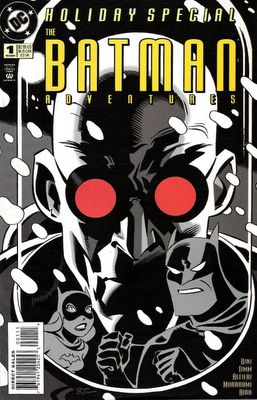
Batman Adventures was often better than the “regular” Batman comic books being published at the time. Like the animated series that it was created to supplement, Batman Adventures offered stripped-down, snappy stories and a classic model of Batman. Free from the clutter of continuity and overly rendered artwork, Batman Adventures concentrated on short, in-and-out 22-page stories where every panel counts and simple visual storytelling is key. They were perfect spinner-rack gateway-drug comics.
I was a big fan of Batman Adventures, particularly when the late Mike Parobeck was doing the art. I should have Mike Parobeck week, that guy was awesome. In addition to the regular Batman Adventures series, DC also published several one-shots, like the Eisner winning Mad Love, and this comic, the Holiday Special.
Now, I think this is right: Mad Love was a comic first and then they made it into a movie, but several of the stories in the Holiday Special were on Batman: The Animated Series first and then appeared in print. Somebody jump in here and correct me if I’m wrong.
Anyway, the Holiday Special is a cornucopia of yuletide joy, Gotham City style. It features a bunch of Batman short stories by Bruce Timm, Paul Dini, Kevin Altieri, Ronnie del Carmen, and Dan Riba, and they’re all swell. There’s a great Batgirl vs Clayface story drawn by Bruce Timm, a sentimental story about a holiday tradition Commissioner Gordon and Batman share (it doesn’t involve kissing), a kinetic Batman vs Joker piece, a moody Mr. Freeze story, and a kick-ass hyperactive bit featuring everyone’s favorite lipstick lesbians Poison Ivy and Harley Quinn.
Then again, they are planning on killing him.
Before he catches up with Freeze, Batman saves a young girl from a car sliding in the snow, and we get this scene (click to enlarge):
Batman, dude! She’s a little kid, ease up on her! This is supposed to be an accessible all-ages Batman, not Asshole Batman. There are other books for that. Ha, ha! I kid. You see, I cleverly inserted the word balloon from another comic into the …. Ah, skip it.
Anyway, the Batman Adventures Holiday Special is like a great big present to comic readers, all wrapped up with a shiny red bow.
I would like to see more comic books like this, please.
Wednesday, September 21, 2005
Which image do you prefer?
The image on the right is a classic wartime painting by the master of Americana, Norman Rockwell. The image on the left is a JSA cover by Carlos Pacheco that features Power Girl's breasts. You make the call.
Much thanks to reader Xakyrie for bringing this to my attention.
Tuesday, September 20, 2005
STRANGE TALES #136 Marvel Comics, 1965

My copy of Strange Tales #136 is beat to hell. If you enlarge the cover image (above) you can see all the creases and even a couple of staples holding the damn thing together. This comic has existed on Earth longer than I have, and it looks like it spent half that time on the bottom of a bird cage or as a saddle blanket for a camel or something. My point is, this comic is falling apart, and I love it all the more because of its decrepit state.
Seriously, look at that cover. How could you not love a comic with a Kirby/Severin cover like that? “Hydra’s Mission: DESTROY S.H.I.E.L.D.!” Wait, isn’t that pretty much always Hydra’s mission? Sure, but this is only the second Nick Fury story in Strange Tales, so we have to give them a break.
In true Marvel style, we get a little bit of hyperbole on the cover: “If you can find a greater mag than this, let us know – we’ll buy it ourselves!” Nowadays that kind of unabashed breaking-the-internet-in-half hype is met with shrugs by fans who have been pounded into a desensitized state by years of empty promises. I mean, there’s only so many times that you can believe that this re-launch of Alpha Flight is going to blow…you… AWAY! But in 1965 this sort of shameless yet tongue-in-cheek marketing theatrics was still fresh and sort of charming. And you know what? At least Marvel backed that shit up in the 60’s – they really DID put out the greatest “mags” and Strange Tales #136 is a good example of how they rolled back in the day.
Each issue of Strange Tales featured not one, but TWO pulse-pounding stories that would shatter your senses and physically blow you out of your seat! If comics today were this intense they would have to have seizure warnings on the covers. In #136 we get a classic Nick Fury, Agent of S.H.I.E.L.D. story wherein ol’ Nick turns the tables on those crummy Hydra bums PLUS a psychedelic saga of Dr. Strange, Master of the Mystic Arts, wherein a lot of sinister, trippy shit happens. With this level of radness, I’m surprised child mortality rates weren’t higher during the 60’s.
The S.H.I.E.L.D. story, written by Stan Lee with breakdowns by Kirby and finished art by John Severin, goes through what must be a typical day in the life of Nick Fury. While he’s strolling along a street in New York City (natch), Nick is being stalked by a HYDRA hit squad. Spotting the creeps, Nick stops in a barber shop for a shave – a barber shop staffed by undercover S.H.IE.L.D. agents, that is! After the hit squad is disposed of, Nick and his boys set an elaborate trap for HYDRA which involves adhesive paste, electrified walls, and Marlon Brando and a stick of butter. I know, sounds gross, doesn’t it?
I may be wrong, but I think this comic is one of the first HYDRA appearances, firmly establishing HYDRA as a more garish version of SPECTRE from the Bond movies. Failure is punishable by death in this serpent-motif underworld organization, and absolute fanatical loyalty is demanded. Remind you of anybody?
Oh, and HYDRA members must work the phrase “Hail Hydra” into a conversation whenever possible. I mean, if somebody sneezes, it’s “Hail Hydra!”
Ditko’s art really makes the story, striking a tone between noir intrigue and cosmic surrelia. The scenes of Dr. Strange dodging Mordo’s minions and skulking about are exotic and shadowy, striking just the right tone. Then, when Dr. Strange travels to a demonic otherworld, shit gets weird in a way that can only be described by uttering one word: “Ditko.”
Stan Lee’s florid dialogue and operatic storyline compliments Ditko’s artwork perfectly in this comic. Kirby is King, but Ditko is also largely responsible for writing the grammar that composes the visual language of the Marvel Universe. Ditko fucking rules.
Dr. Strange is sucked into a bizarre world where a nameless demon hypnotizes his prey with googly eyes, then transforms them into soul masks and grafts them to these giant totem pole things. He almost catches Dr. Strange – almost. In the end, Dr. Strange schools the demon and Goes Nuclear, destroying the entire dimension. That’s what happens when you screw with Dr. Strange.
Who else was drawing stuff like this in the 60’s? No, I’ll answer for you: nobody.
Monday, September 19, 2005
Friday, September 16, 2005
NEW MUTANTS #18 Marvel Comics, 1984
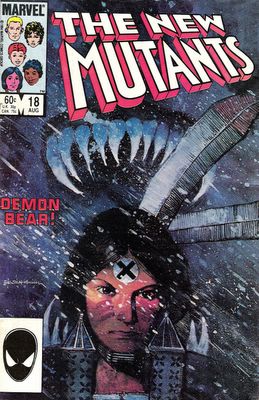
This is one of my most treasured comic books: New Mutants #18, by Chris Claremont and the superhumanly bad-ass artist Bill Sienkiewicz. The copy I own today is the same one I picked up from a comic shop in Bellevue, WA back in 1984, and like all of my Important Comics, I have read, looked at, and smelled my beat-up copy countless times.
Part one of the two-part Demon Bear storyline, this issue focuses on young Danielle Moonstar, a mutant student at Xavier’s School whose dreams are haunted by the demon bear that killed her parents. Danielle prepares for an inevitable, fateful confrontation with the bear in the physical realm – and meets her destiny in the snowy woods outside Xavier’s one night.
This comic book blew my 15 year old mind.

I had never before seen art like this in a monthly comic book. Sienkiewicz’s work on this comic and all of his New Mutants work really broadened my perception of the possibilities inherent in the medium, of what comics could be. Here, printed on the same crappy newsprint as the issue of Micronauts I no doubt picked up at the same time, is a little masterpiece of technique and design disguised as disposable children’s entertainment.
I can’t overstate how revolutionary Bill Sienkiewicz’s art seemed at the time. This run made me a lifelong fan of his work, particularly Elektra: Assassin, which is just an insane acid-trip of a comic. I credit Sienkiewicz with opening doors in the comic industry for more progressive artists like Dave McKean and David Mack. It seems to me that Sienkiewicz’s work on New Mutants changed everyone’s perceptions about the limits of comic book art in a monthly format. Okay, I may be overselling his influence – I am prone to fits of hyperbole every know and then – but I really feel like Bill Sienkiewicz was a revolutionary figure in comic books. He was with me, anyway.
Sienkiewiecz's art really elevates Claremont's story, which is bogged down a little by the subplots and mannered dialogue that he is so known for today. This issue just goes to show what a collaborative form comic books really are. The New Mutants series started out with rather conventional comic book art illustrating Claremont's scripts (check out the upper left corner of the cover, above, to see what the characters looked like prior to Sienkiewicz) but soon made a sharp left turn into magic mushroom land when Bill S came on board. The writing had not changed, but the change in artists had a profound and positive effect on the book, and everybody wins.
Check out these panels, below. Sienciewicz takes what in script form may seem like a pretty straightforward sequence - Dani walks outside, challenges the Demon Bear to show himself - and transforms it into something special, something mythic and foreboding:
On one level it’s a pity that this beautiful art is printed on this twenty-two year old pulp paper – you can tell by these scans that the production and material aren’t equal to the art itself. It’s sort of a shame because I think it needs to be reprinted on paper that is equal to its radness. Have they ever reprinted these books? Anybody? Dan Coyle?
But on another level, I like having the original comic that Young Dave read over and over in 1984 and in all the years after. It’s a little imperfect relic from my youth, from those early days of discovery and hope before I grew up and was seized by an existential terror, before I realized that only the cold void, the black and unimaginable emptiness of death awaits us. Nothingness – that is our destiny and birthright as mortals. The void calls all of us.
Woah! Hello, Sylvia Plath? Somebody’s stealing your routine! I don’t know what that was about; sometimes the meds wear off and I just write shit.
Right, back to the comic. Here's the big full-page money shot of Dani facing the Demon Bear:
Anyway, New Mutants #18 is one of the Important Comics in my collection because of its sentimental value and because it opened my puny mind to the possibilities available to comic creators when they stop letting the conventions of the media dictate what they can and cannot put on the page. The possibilities, man…
Tell me that doesn't rule.
Thursday, September 15, 2005
STAR TREK - X-MEN Marvel & Paramount Comics, 1996
This comic is officially sanctioned fan fiction, however, published with Marvel and Paramount’s blessings. It’s kind of a strange comic, because it teams up such radically different properties. I’m sure that Star Trek and X-Men share a similar fanbase/demographic, but really, was there ever a huge public demand for this crossover?
Let’s imagine that there was a keen interest in a Star Trek/X-Men crossover. I think a conversation between two interested fans might sound - a little something like this (that phrase is always the prelude to comedy fun) :
X-MEN FAN: I hope they have Spock and Wolverine fight. That would be awesome.
TREKKER: Why would they fight? Spock would just employ logic and he would just reason with Wolverine.
X-MEN FAN: Not if he’s mind-controlled or infected by the Brood or something. I hope they have The Brood. That would be awesome.
TREKKER: They better not. I wrote an X-Men/Trek fan fic with The Brood back in 1996. I would sue them. Anyway, if Wolverine was in a feral state, Spock would just nerve pinch him.
X-MEN FAN: He could try, but it would be his funeral. Wolverine would gut him like a fish. Spock sucks.
TREKKER: Spock is an enduring cultural icon that is known throughout the world, an important—
X-MEN FAN: Spock is a tool. Wolverine would kick his ass. Spock would be all, “Live long and prosper!” And Wolverine would be all, “UNNGHH! Stab you!!!” And Spock would be all, “Aaaagh! My face!”
TREKKER: I can’t even talk to you when you’re like this.
Man, making cheap jokes about geeks is always 100% comedy gold. Hilarious.
I guess what I’m saying is that I don’t think that the worlds of Star Trek and The X-Men don’t really go together like peanut butter and chocolate, but go together they must, or there wouldn’t be a Star Trek/X-Men comic, now would there?
The book was written by Scott Lobdell, a Marvel mainstay during the 90’s, with art by a rotating stable of pencillers and inkers. Initially the book is drawn by Marc Silvestri with background assists by Brian Ching, but then Billy Tan, Anthony Winn, and David Finch jump in on pencils, and we get inks by Batt, D-Tron, Billy Tan, Aaron Sowd, Joe Weems, and Hugh G. Rection. Actually, sorry, Hugh G. Rection did “ink assists” along with Victor Llamas, Team Tron, Jose Guillen, Viet Troung, and Mike Manczarek. Four different people did the colors, and a dog named Mr. Tex* gets a vanity assistant editor credit. You might think with so many people working on the art that the comic might seem a little uneven, but you’d be wrong!
No, just kidding, you’d be right.
The book is a frickin’ mess. Since the art shifts from page to page, it’s like watching the story through a funhouse mirror. Captain Kirk’s facial structure morphs from page to page, getting worse as the comic goes on, until it reaches a point where Kirk is mutating before our very eyes.
The story awkwardly grafts the crew of the Enterprise and Xavier’s mutant superheroes into an interdimensional plot where they have to team up and face the double menace of psycho Trek telepath Gary Mitchell and the omnipotent Proteus from X-Men. Throw in some Shi’ar, some Wolverine, you got yourselves a story. Not a great story, but a story regardless.
I grudgingly admit that there are a few fleeting moments of coolness, like Kirk hitting on Jean Grey, or the Enterprise facing yet another super-powerful menace in space – Gladiator from The Imperial Guard:
Overall, the erratic art production and the awkward fusion of the two worlds undermines any potential coolness inherent in Star Trek/X-Men. The characters just don’t work together. Even when they occupy the same panel, the Trek and X-Men characters exist in different physical universes. Check out this panel of Kirk and Spock in their terry cloth uniforms next to the hyper-accentuated super-physiques of the X-Men:
It’s like, they couldn’t draw Kirk and Spock with huge muscles to make them proportionate to the X-Men, but they couldn’t tone the X-Men down and make them less… I don’t know, less Silvestry. There, I just made up a word.
Silvestry (adj): A quality of comic art that exaggerates human musculature for dramatic effect. Ex: “Check out this picture of The Punisher, he looks totally Silvestry!”
You’re probably all wondering who wins the inevitable Spock/Wolverine fight, aren’t you? I mean, that’s why I got this comic, to see these two wildmen duke it out, no holds-barred. So who wins?
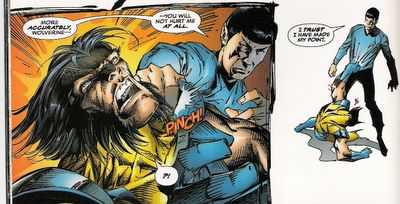
Spock takes him down to Chinatown! Lays the Vulcan nerve pinch on his mutant ass! That just goes to show: don’t underestimate The Spock, man. You better bring your “A” game when you step up to The Vulcan.
I actually don’t think that Spock laid the nerve pinch on Wolverine, I think he was transmitting a crosshatching nanovirus which buries the target under the crushing weight of gratuitous inking. There must be five pounds of ink on Wolverine’s forehead alone.
Of course, that trick only works in the comics...
*This is a lie. There is no Mr. Tex.
Monday, September 12, 2005
BOOB WAR CLIMAX! Everybody Loves Power Girl!
Ahh, Power Girl.
I love Power Girl, and I don't know why. Well, actually, I do know why, but it's for completely juvenille reasons.
Power Girl is at once the most generic and most sexualized super heroine in mainstream comics. I believe that they key to whatever popularity Power Girl has is her generic, blank-slate quality – she is a tabula rasa that comic book fans and creators alike can project their conscious and unconscious desires on to.
That, and she is built like a brick outhouse.
Power Girl’s bosom is her most prominent feature, and prominent is the word. If she were real, and she showed up to rescue you, you would be going, “Daaamn!” Eye contact with her would be impossible –such is the er, power of Power Girl’s Magical Cleavage.
Observe: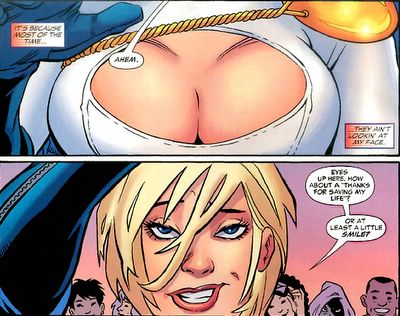
Power Girl rivals Lady Death, Lara Croft, and Battlechasers’ Red Monika in terms of cup-size, but there’s a key difference: The other characters I mentioned were designed with large breasts at their inception, whereas Power Girl has evolved over the years into her current statuesque mode through a sort of tribal tradition among creators. It's been said that when artist Wally Wood was inking over Ric Estrada's pencils on All-Star Comics, he kept making Power Girl's breasts bigger and bigger - just to see if his editors would cry "foul." Now it is an accepted and consistent convention in DC Comics – Power Girl must be drawn with giant breasts.
That is about the only thing that’s consistent about Power Girl.
There have been like, seventy different origin stories for Power Girl, and fifty different costumes. The character is so generic that numerous different artists and writers have tried to spice her up by screwing around with her back story or giving her new clothes or new powers. Who can blame them? Power Girl is not an inherently interesting character.
Sorry, it has to be said. Power Girl is kind of boring.
I mean, she’s okay on super-teams and stuff, but I don’t know how inherently gripping she is as a character. I don’t think I’m alone on this, which is why editors and writers have tinkered with her backstory, to the point where Power Girl has now had three entirely different origin stories.
Sadly, the results of all this tinkering have just made the character less interesting and her story more complex than you would think her bland nature would warrant.
Okay, I’ll lay off Power Girl. It’s not as if I dislike her or anything, it’s just that I’ve never read a Power Girl story that gripped my shit, so to speak. I mean, don't get me wrong, I like boobs. See?
Let's talk about Power Girl's origin(s). Originally she was Superman’s cousin, a Kryptonian with all the attendant powers. They scrapped that, and decided she was actually an Atlantean, sent forward in time by her grandfather Arion. Why? Something about giving birth to the savior of humanity or something. The current origin story, as I understand it, is that Power Girl is a refugee from the future, an amnesiac former member of the Legion of Super-Heroes. Sure, why not? That’s no worse than the other two origins they had for her.
Her powers? The original Kryptonian-version Power Girl had powers and abilities on par with Superman, but DC rightly concluded that having two Kryptonians flying around didn’t make Superman seem very super. During a Justice League Europe crossover called “The Teasdale Imperative,” Power Girl sustains a magical injury which greatly reduces her power from Superman-levels to, I don’t know, Starman levels.
Here's Justice League Europe #9, where Power Girl gets her powers reduced after getting seriously injured. Only Superman can save her, with his healing heat vision! Or something. And should she be wearing her outfit in surgery? I know it's flattering, but is it sanitary?
Anyway, the cover:
After that, DC started coming up with crazy powers and vulnerabilities for Power Girl out of left field. In Birds of Prey she had telekinesis. In a guest-spot in the pages of Supergirl, she was vulnerable to – let me see if I got this right – natural, unprocessed material. In other words, if you smack her with a rake, it wouldn’t hurt, but if you smack her with a hickory stick, it would. That would be a bad idea: smacking Power Girl with a hickory stick.
Anyway, I don’t know where these powers came from – presumably they were riffs on her Atlantean heritage (Origin #2), though I blame REM – Random Editorial Mandate. I'm really big on gratuitous acronyms these days.
Her costumes? In my mind, the ultimate, classic Power Girl costume is the white peek-a-boo number with what I like to call the Magical Cleavage Window:
Another classic costume featured a positively canyonous décolletage, made popular by artist Bart Sears:
There was also a version of the classic costume that had no Magical Cleavage Window at all. This costume is stupid and misses the entire point of Power Girl in the first place. No cleavage = no Power Girl. I'm not even going to post a picture of that costume, because really, that's not why we're here.
After her powers were reduced, Power Girl wore a gold and white costume in the pages of Justice League Europe. Here's a scene where The Flash leers at Power Girl's new costume in front of a couple of kids. 100% class. Click to enlarge:
I actually didn’t mind this costume, except Power Girl needs a cape. She’s a cape kind of heroine. No cape = no Power Girl. But what is up with the collar on that outfit? It’s like she has a weird disco muffler built into her outfit. Does she get chilly or something?
During the Gerard Jones era of Justice League Europe she wore a blue and white costume that supposedly "reflected her Atlantean heritage." There’s a cape of sorts and the Magic Cleavage Window is back, so that’s good, but otherwise I think this costume sucks. It looks like what people in the eighties thought that disco workout wear would look like in the year 2000.
Look, not only does Power Girl have bosom cleavage, but she also has cute butt cleavage.
Anyway, these days Power Girl is back with the classic white Magic Cleavage Window in JSA every month, and recently in JSA: Classified. And don't think people don't comment on the Magic Cleavage Window.
You see, in the fictional universe that she inhabits, all the other superheroes think Power Girl is totally hot. All of them (except Aquaman).
Power Girl is the premier superhero sex object in the DC Universe – among her peers, she alone occupies the unique role of the Super Bombshell.
Traditionally DC writers, through the voices of other characters and mechanics of plot, have emphasized Power Girl’s sexuality – not just the art, but the stories themselves emphasized Power Girl’s super hotness. Male heroes like Firestorm and The Flash try to hit on her. Even Superman and Batman think she’s hot. Her various costumes always illicit comments from her fellow heroes. In several comics, characters develop obsessive sexual fixations on Power Girl. People always comment on or check out or try to grab her breasts.
Seriously, she has got to be the most sexualized – dare I say, objectified? – heroine in mainstream spandex comics.
What? You don’t believe me? You're stupid. Take a look. Everybody wants Power Girl. Well, except for Aquaman. But Aquaman is gay. I'm not judging or anything; I think it's cool. I say, go Aquaman.
Firestorm had the "hots" for Power Girl, as we see here in Justice League of America Vol 1 #208: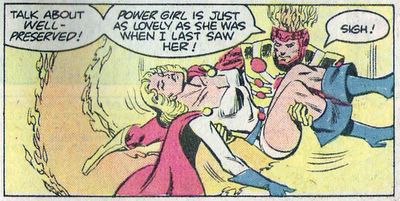
Firestorm, you're never getting a woman as long as you keep wearing that outfit.
Of course, The Flash wants Power Girl, too, but he is more crude and open about it. In the pages of Justice League Europe he continually makes unprofessional sexual comments to Power Girl:
Okay, that's just sexual harassment right there. Power Girl and Flash are in a work environment, and he needs to recognize that. But no, The Flash continues to harass his co-worker, establishing an unprofessional climate and enabling harassment by other heroes.
Don't believe me? Here's a scene from Justice Leauge America #113. Our heroes have been captured by an evil alien hunter Flicker and are chained up. Blue Devil decides to sexually harass Power Girl into a berserk rage that will let her bust loose. Take a look:
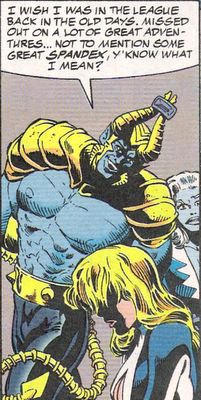
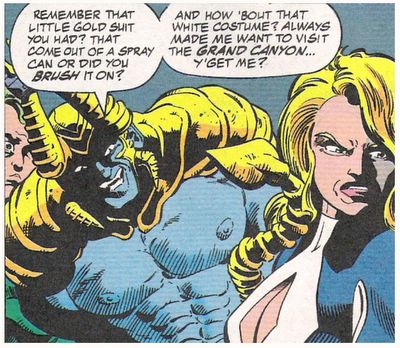
Power Girl is the Anita Hill of super heroes.
Seriously, none of the other Justice League women have to put up with harassment like that, not even Fire. You ever see somebody pulling that with Wonder Woman? "Hey, Wonder Woman. Nice ass. You work out?" No. She would flatten them. But Power Girl has to deal with this shit all the time.
And don't think that bad guys aren't trying to cop a quick feel in combat: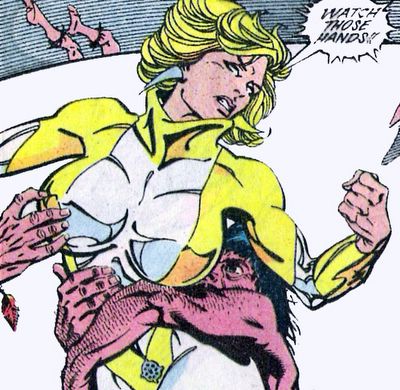
Everywhere she goes, people ogle and leer at Power Girl. I suppose in one way it's a realistic reaction, because again, if she showed up on a city street she would cause traffic accidents from all the drivers going, "Daaamn!" But on the other hand, people don't drool all over Wonder Woman when she goes out in public. Or if they do, they keep it on the down-low.
Here, look, check out the sailors in the background scoping PG out in this panel from Birds of Prey #42. They look both frightened and aroused, perhaps because of artist Glenn Fabry's extra-muscular interpretation of her:
Nobody is exempt from the hypnotic power of the Magic Cleavage Window. Everybody checks Power Girl out (except Aquaman), even Jimmy Olsen. Here he is sneaking a peek in the pages of a recent JSA Classified:
Power Girl's hotness is such a universal fact that Superman and Batman exploit it to tactical advantage in Superman/Batman #4. They don't come out and say it, but basically they say, "Power Girl, can you distract our foe with your breasts for us?"
Not to beat a dead horse, but nobody asks Wonder Woman to shake her ass in front of a bad guy, even if it is for a good cause.
Even out of costume, Power Girl is the subject of unwanted attention. Here's a panel from Hawkman, where the Village People encourage Power Girl to flash them:
Holy shit! Those are big, even by Power Girl standards.
Everyone comments on Power Girl's breasts, even women. Take the Body Doubles mini-series, for example:
Why is it that they remark on the size of Power Girl's chest, but not on the fact that her nipples are missing? Ahh, because the Body Doubles girls don't have nipples either!
In Gerard Jones' Justice League Europe, entire pages are spent discussing Power Girl's costume and the Magical Cleavage Window. Here's PG, Dr. Light, and Crimson Fox, who seriously must have the goofiest costume ever. Does she even look like a fox? And is she crimson? They should have called her Brown Cobra instead.
Anyway, Brown Cobra even comments on PG's cleavage:
You go, Power Girl!
In all the long years I've been collecting comics, I've learned that comic covers are nearly always improved by the presence of breasts. It stands to reason that comic covers with Power Girl on it would be excellent - and focused on one thing.
Well, two things:
What's the first thing you notice on that cover, above? The turkey? The Atom on the table welcoming everyone to his fa-bulous show? Or maybe Power Girl's breasts? Don't worry, you're not alone; it looks like Superman is taking a look as well. Such is the power of the Magical Cleavage Window.
For my money, a Power Girl cover isn't effective unless it emphasizes That Which Makes Power Girl Special...
...as long as Power Girl's chest is the focus of the piece, I'm happy:
However, I'll settle for crude symbolism in lieu of breastage:
Perhaps with this new origin we are entering a new era of Power Girlhood, in which she becomes a little more, um, fleshed-out as a character. Maybe writer Geoff Johns is the one who will finally rise and give Power Girl the props she deserves, and she can transcend her bra-size and become a more fully realized character. It would be a shame if Power Girl were just about the boobs.
Can't we as comics readers have both? Can't we have an incredibly stacked superheroine and and interesting character at the same time? I want it all. I want Power Girl to kick ass, to be written well, and have big boobs at the same time - something for everyone!


